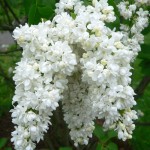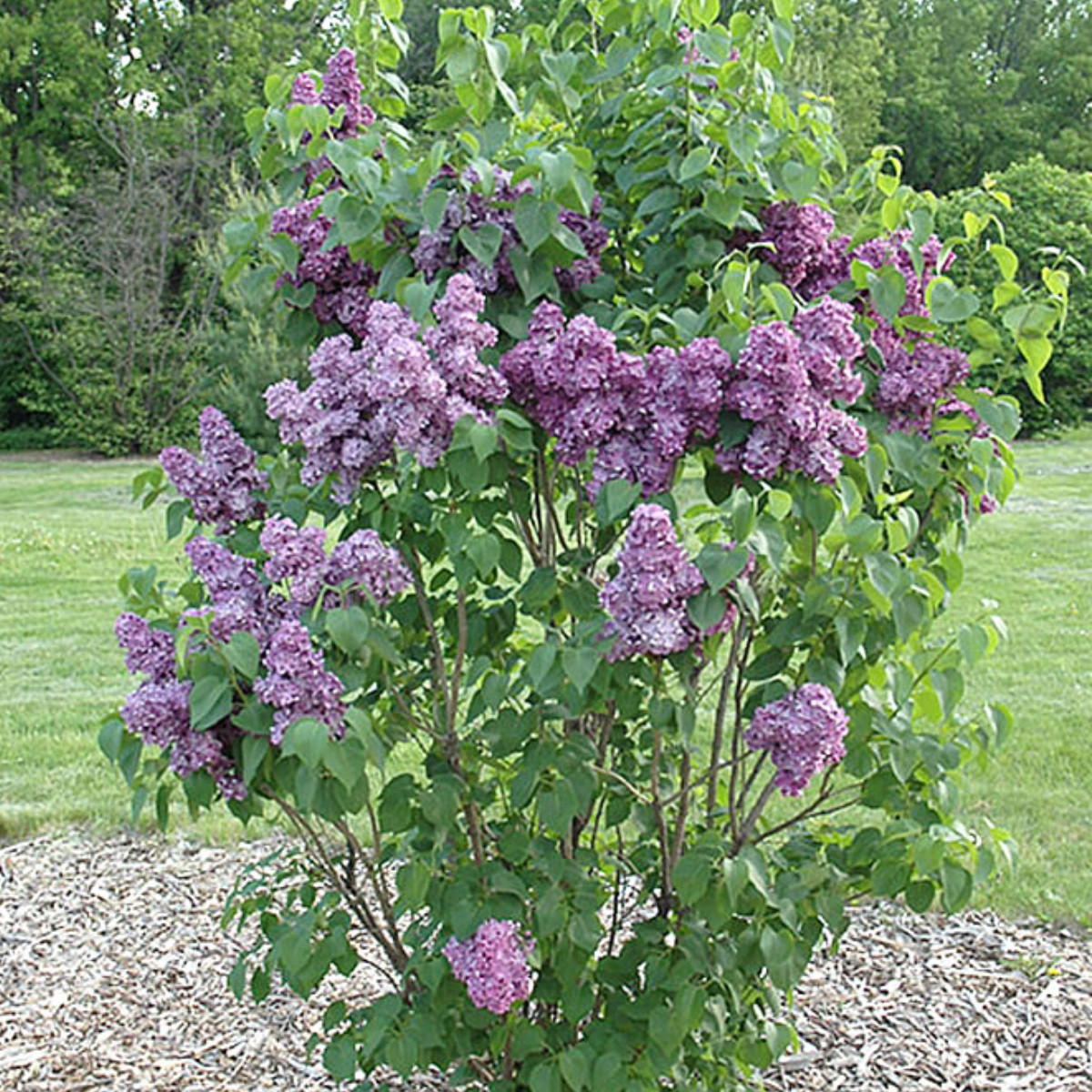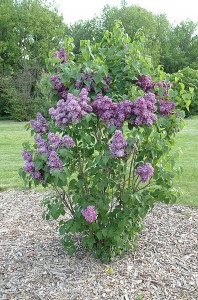Family: Oleaceae
Distribution and habitat: Syringa vulgaris is native to the Balkan Peninsula, where it grows on rocky hills. It is widely naturalised in western and northern Europe and in North America.
Description: Syringa vulgaris is a large deciduous shrub or multi-stemmed small tree, growing to 67m (2023 feet) high. It produce secondary shoots, named suckers, from the base or roots, with stem diameters of up to 20cm (8 inch), which in the course of decades may produce a small clonal thicket. The bark is grey to grey-brown, smooth on young stems, longitudinally furrowed and flaking on older stems. The leaves are simple, 412cm (25 inch) and 38cm (1-3 inch) broad. They are light green to glaucous, oval to cordate, with pinnate leaf venation, having a mucronate apex and an entire margin. They are arranged in opposite pairs or occasionally in whorls of three.
The flowers have a small tubular base to the corolla with an open four-lobed apex, usually lilac to mauve, occasionally white. They are arranged in dense, terminal panicles 818cm (37 inch) long. Syringa vulgaris is a very popular ornamental plant in gardens and parks, because of its attractive, sweet-smelling flowers, which appear in early summer just before many of the roses and other summer flowers come into bloom.
The fruit is a dry, smooth brown capsule, 12cm (0.4-0.8 inch) long, splitting in two to release the two winged seeds.
Garden Culture: Pruning can help keep it to a more desirable height. The shape can be irregular, oval or round. Cut away any unwanted suckers. Mature plants can be severe pruned out of older wood, so that the shrub is always producing new wood to bloom on. It is a moderate grower.
Syringa vulgaris set next year's flower buds shortly after current year's flowers fade. Deadhead should be done before the new flower buds form.
To improve the flowering of lilacs, keep the grass from growing around them. A 40 to 60cm (16-24 inch) circle of landscape cloth placed around the bushes and covered with bark or stone will keep the grass down.
It will require a period of chilling dormancy.
Position: Plant Syringa vulgaris in full sun exposure - at least 6 hours of sun light per day. The shrub will grow in heavy shade, but will likely fail to produce many (if at all) of the prized blooms.
Soil: It is hardy and easily grown in well-drained, sandy and gravelly, preferably neutral to slightly alkaline soil. It does not do well in clay soils. If the soil is in poor condition, add compost to enrich it.
Plant in either spring or autumn. Transplanting Syringa vulgaris from a nursery is also easy. If it is container-grown, spread out the roots when settle the plant into the ground; if it is balled or burlapped, gentle remove it and any rope before planting.Set the plant 5 or 8cm (2-3 inch) deeper than it grew in thenursery and work topsoil in around the roots. Water in. Then fill in the hole with more topsoil. Space multiple shrubs 1.5 to 4.5m (5-15 feet) apart, depending on the variety.
Irrigation: Keep new plants well watered the first year. Once established, these shrubs are very drought tolerant.
They do not like wet feet and will not bloom with too much water.
Fertilising: If the soil is rich, they would not need any food at all. If the soil is on the lean side, an early spring dose of fertilizer for flowering shrubs will keep them blooming. These shrubs will not bloom if overfertiliser.
Propagation: The species may be raised from cuttings, layers or grafts and from seed.
Propagation by cuttings is one of the most popular ways to propagate Syringa vulgaris. Cuttings should be taken when new green terminal shoots are produced. They should be 10 to 15cm (4-6 inch) long, but should not be left out too long, because they will wilt easily and die. The cutting should be dipped in a rooting hormone. The cuttings can be placed in a media with peat, vermiculite and perlite. Each cutting should contain 2-3 nodes, which are the growing points where the leaves are attached. The leaves aid in rooting by producing carbohydrates for the rooting plant. The cuttings should never be allowed to dry out and should be kept moist at all times. The cutting should root within 3-6 weeks. Once roots appear, place the plant outside in a desirable location.
Propagating Syringa vulgaris by air layering can be easily done. Pick the part of the plant desired to be propagated. Then cut a slit at an angle 1/3 of the way through the stem just below good, healthy leaf growth. Hold this slit open with a toothpick and dust or spray the cut with a rooting hormone. Take a length of plastic wrap and secure with a twist tie or string around the stem below the cut. Fill this pocket with a big handful of moistened spagnum peat moss and wrap the rest of the plastic around it making sure to over lap and seal it to the stem above the cut with another tie. Use waterproof tape to seal the over-lapped edges of the plastic. Make sure the peat moss is in good tight contact with the cut. Keep the peat moss moist during the rooting process by opening the pocket at the top and adding water when required. When roots are visible in the the peat moss, cut the stem off below the root mass and pot up.
The most common type of grafting done to Syringa vulgaris are either cleft grafts or bud grafts. The process requires a great deal of knowledge and can take several months in a greenhouse or glass-covered frame, where the air is kept moist continuously in order for the grafts to take. Cleft grafting is the most common way of grafting on a commercial basis. Bud grafting is an economical and a very rapid method for obtaining a big number of new plants.
Growing Syringa vulgaris from seed is an uncommon approach and takes long time. It usually takes 3-4 years before the shrub will finally get first blossom. Horticulture greenhouses do plant them by seed in order to use them for rootstock for other methods of propagation. At the end of the season, harvest the seed from the dead flowers after they have dried, but before they fall out of the seed pods onto the ground. Seed propagation of this shrub require a process of stratification (or a cold period) of 40-60 days in order to remove the pysiological dormancy of the seed that is needed for germination.
Problems: Insects are rarely a problem on Syringa vulgaris.
Powdery mildew is common on this shrub, especially in humid and wet summers.
Treatment: Provide good air circulation by keeping their branches pruned. Prune right after blooming is over. In addition to branch pruning, cut the dead flowers off when they are done blooming.
Oystershell scale can attach to the trunk and branches.
Treatment: Horticultural oil will help, if caught early.
There is also a lilac borer.
Treatment: The borer prefers older wood, so regular pruning will keep them at bay.
Leaf miners can make the leaves unsightly, but they would not do serious harm.
Uses: Syringa vulgaris bushes are attractive enough to be treated as specimens. They are also often planted in rows along property borders and pruned into hedges. They make excellent features for cottage garden style.
The smell of their flowers are among the most fragrant flowers. They are used as cut flowers in classic bouquets.
Because lilacs are fire retardant, they can be considered for planting near homes that are susceptible to wildfires.
Hardiness zone: 3-7






